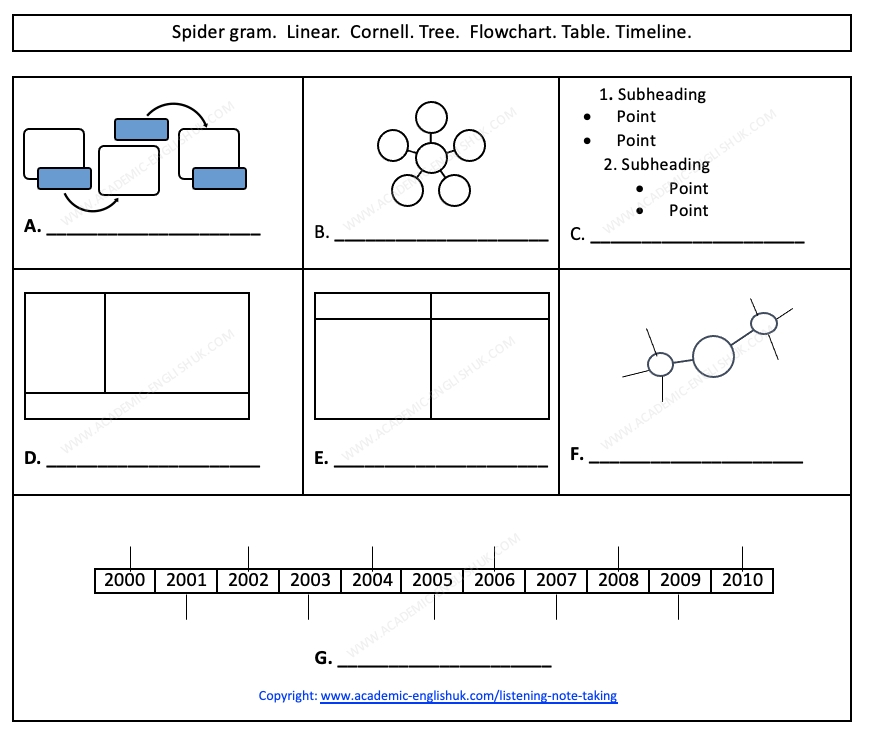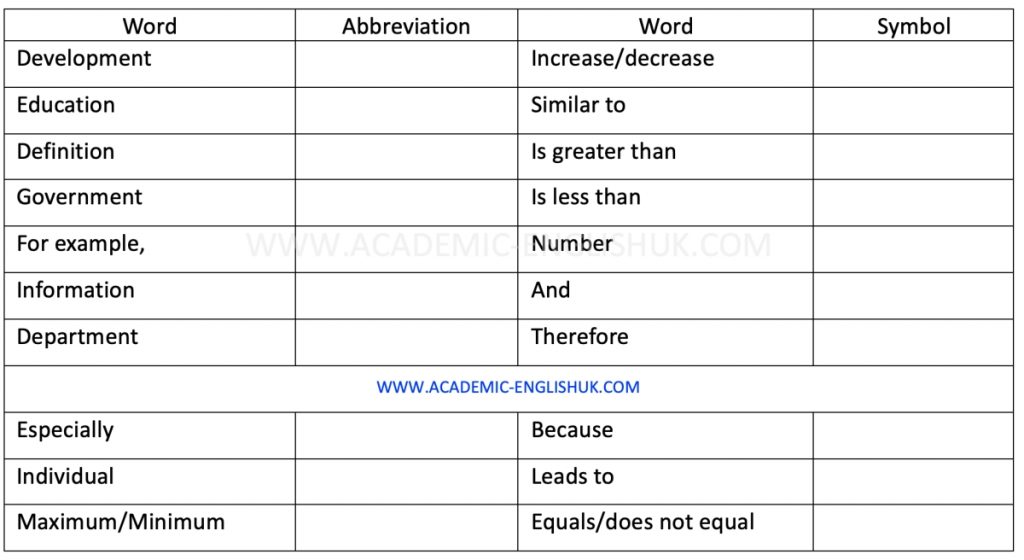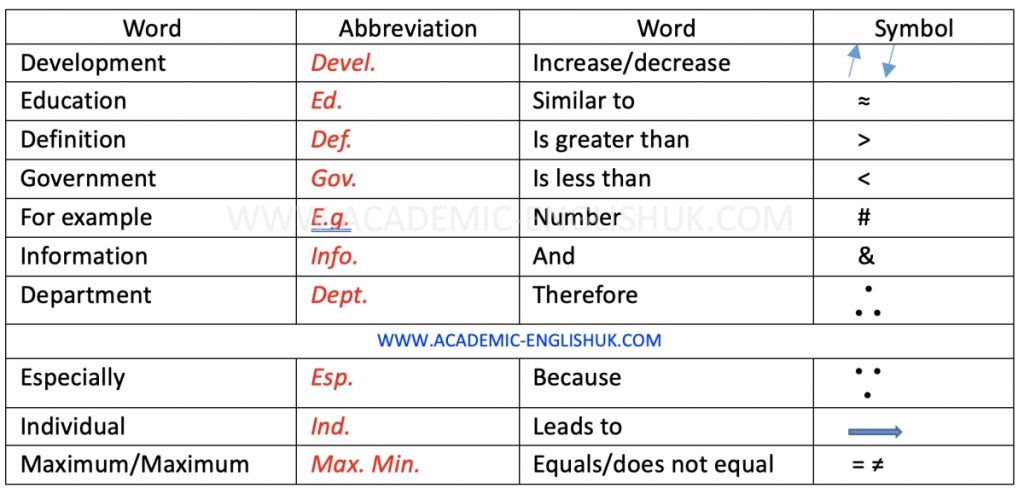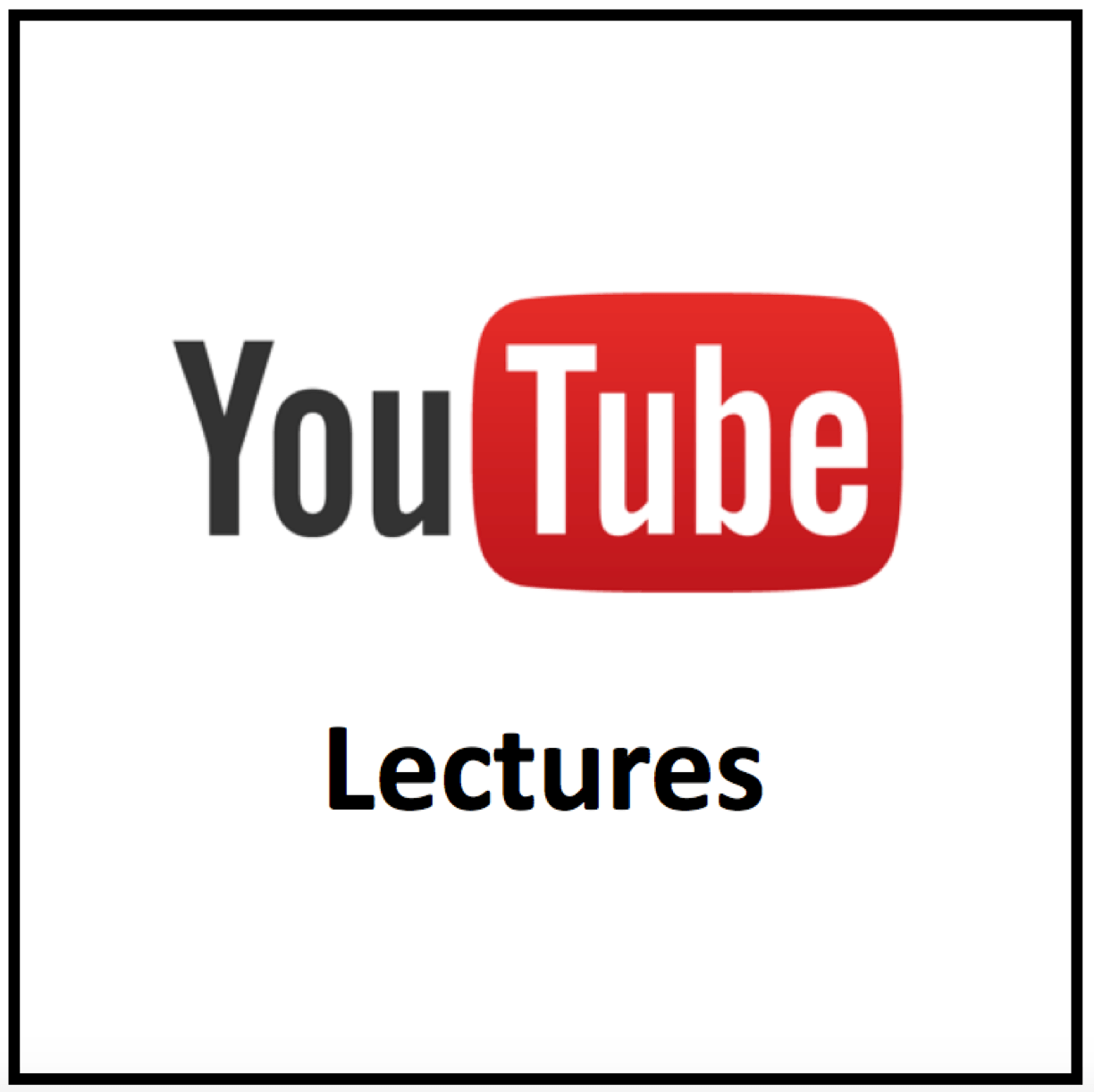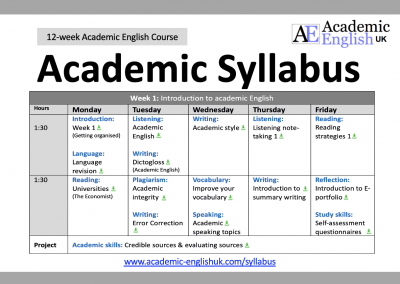Listening Note-Taking Methods 1
What are listening note-taking methods?
The Curve of Forgetting graph (originally called The Ebbinghuas Curve) proposes we forget new information rapidly. If you take a lecture for example, many students think that because they understand the content, they don’t need to take notes but this understanding or retention can fall to 40% within just 48 hours. Thus, note-taking is an important skill for recall and review at a future date.
There are many methods of note-taking and every individual is different but using a variety of techniques can only improve the efficiency of good note-taking. This webpage provides a range of methods to help students improve this skill.
Listening note-taking methods lesson downloads
Note-taking Skills 1
Listening note-taking methods 1 [new 2021]
This lesson is an introduction to taking notes using a variety of methods. It begins by providing a guide to seven common methods. The lesson includes five 30-second listenings, two 2-minute listenings and one 8-minute lecture to practice using these methods. Example Time: 90-120mins. Level ***** [B1/B2/C1] Video [08.50] / MP3 / TEACHER MEMBERSHIP / INSTITUTIONAL MEMBERSHIP
Note-taking Skills 2
Listening note-taking methods 2
This lesson is an introduction to abbreviations and note taking using linear, mind map and table methods. The lesson includes four approximately 2-minute lectures and one 8-minute lecture to practice using these methods. Example Time: 90-120mins. Level ***** [B1/B2/C1] Video [07.00] / MP3 / TEACHER MEMBERSHIP / INSTITUTIONAL MEMBERSHIP
Note-taking Skills 3 (Technology)
Listening note-taking methods 3 (Technology): Cornell Notes System
This lesson introduces students to the Cornell notes system. It starts with the students discussing their note-taking experience before introducing them to Cornell’s 5Rs. They then practice using this method by listening to five mini lectures on subjects connected to technology. Sample notes for each lecture are included. Example Time: 90-120mins. Level ***** [B1/B2/C1] Video [08.35] / MP3 / TEACHER MEMBERSHIP / INSTITUTIONAL MEMBERSHIP
Note-taking Skills 4
Listening note-taking methods 4 (Science): Cornell Notes System
This lesson introduces students to the Cornell notes system. It starts with the students discussing their note-taking experience before introducing them to Cornell’s 5Rs. They then practice using this method by listening to five mini lectures on subjects connected to science. Sample notes for each lecture are included. Example Time: 90-120mins. Level ***** [B1/B2/C1] Video [09.18] / MP3 / TEACHER MEMBERSHIP / INSTITUTIONAL MEMBERSHIP
Listening Note-Taking Methods 1 (note-taking)
Label the note-taking methods with a word from the box:
Note-taking methods
- What method of notes would you take for the following lectures?
Listening note-taking video (08:53)
Listening note-taking methods 1 [new 2021]
This lesson is an introduction to taking notes using a variety of methods. It begins by providing a guide to seven common methods. The lesson includes five 30-second listenings, two 2-minute listenings and one 8-minute lecture to practice using these methods. Example Time: 90-120mins. Level ***** [B1/B2/C1] Video [08.50] / MP3 / TEACHER MEMBERSHIP / INSTITUTIONAL MEMBERSHIP
Listening Note-Taking Methods 2 (abbreviations / symbols)
One strategy for taking good notes is to use abbreviations and symbols. What would you use for the following words?
Note-taking methods: ‘linear’
- One common way to make notes is using a linear method. You can organise your notes using headings, numbers and bullet points. Look at the examples:
To practise this skill to a mini-lecture, go to the listening note-taking methods 2 download below:
Note-taking methods: ‘mind map‘
- Another common method for taking notes is to use a spidergram (mind map). This is a good way to show relationships between ideas. Look at the example:
To practise this skill to a mini-lecture, go to the listening note-taking methods 2 download below:
Note-taking methods: ‘table‘
- Another common method for taking notes is to use a table. This is a good way to show comparison of two things. Look at the example:
To practise this skill to a mini-lecture, go to the listening note-taking methods 2 download below:
Note-taking methods: ‘combination of linear and table‘
- Most of the time we take notes using a variety of different methods. We may start with linear but then we may include a spider gram to show cause and effects or a table to show comparison. Look at the following example:
To practise this skill to a mini-lecture, go to the listening note-taking methods 2 download below:
Listening note-taking video (07:00)
Listening note-taking methods 2
This lesson is an introduction to abbreviations and note taking using linear, mind map and table methods. The lesson includes four approximately 2-minute lectures and one 8-minute lecture to practice using these methods. Example Time: 90-120mins. Level ***** [B1/B2/C1] Video [07.00] / MP3 / TEACHER MEMBERSHIP / INSTITUTIONAL MEMBERSHIP
This technique of note-taking is called “Cornell Notes System”. It is a system for taking, organizing and reviewing notes and has been devised by Prof. Walter Pauk of Cornell University in the 1950s. The paper is divided into three areas: note-taking area, cue column and summary. When listening to a lecture you follow five stages:
The five stages:
Stage 1: Record
During the lecture, record as much information as you can in the main column (note-taking area).
Stage 2: Reduce
After the lecture, complete the left column with questions about the content in the main column. These questions can be answered when you’re reviewing the lecture.
Stage 3: Recite
After the lecture, cover the main column and ask yourself the questions from the left column. See if you can answer the questions without looking at your notes in the main column.
Stage 4: Reflect
Think about your own opinions and ideas as you read over your notes. Write these ideas down in a notebook and then use them in essays, exams, seminars or presentations.
Stage 5: Review
Spend ten minutes per week reviewing your notes.
Listening note-taking 3 video (08:53)
Listening note-taking methods 3 (Technology): Cornell Notes System
This lesson introduces students to the Cornell notes system. It starts with the students discussing their note-taking experience before introducing them to Cornell’s 5Rs. They then practice using this method by listening to five mini lectures on subjects connected to technology. Sample notes for each lecture are included. Example Time: 90-120mins. Level ***** [B1/B2/C1] Video [08.35] / MP3 / TEACHER MEMBERSHIP / INSTITUTIONAL MEMBERSHIP
Listening note-taking 4 video (09:18)
Listening note-taking methods 4 (Science): Cornell Notes System
This lesson introduces students to the Cornell notes system. It starts with the students discussing their note-taking experience before introducing them to Cornell’s 5Rs. They then practice using this method by listening to five mini lectures on subjects connected to science. Sample notes for each lecture are included. Example Time: 90-120mins. Level ***** [B1/B2/C1] Video [09.18] / MP3 / TEACHER MEMBERSHIP / INSTITUTIONAL MEMBERSHIP
Another interesting lecture lesson
Active listening video (05:33)
Active listening lesson download
4 tips to improve active listening skills by A.Lyon [new 2021]
This lesson is an introduction to active listening. It focuses on four key improvements to become a better active listener. It includes a set of listening questions and an active listening speaking task (mirroring, paraphrasing, summarising and clarification). Example Time: 90-120mins. Level ***** [B1/B2/C1] Video [05.33] / MP3 / TEACHER MEMBERSHIP / INSTITUTIONAL MEMBERSHIP
Listening resources / worksheets




